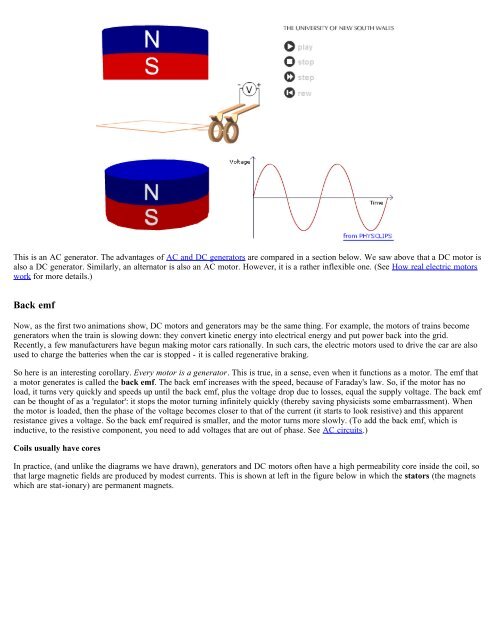How real electric motors work - School of Physics - The University of ...
How real electric motors work - School of Physics - The University of ...
How real electric motors work - School of Physics - The University of ...
You also want an ePaper? Increase the reach of your titles
YUMPU automatically turns print PDFs into web optimized ePapers that Google loves.
This is an AC generator. <strong>The</strong> advantages <strong>of</strong> AC and DC generators are compared in a section below. We saw above that a DC motor is<br />
also a DC generator. Similarly, an alternator is also an AC motor. <strong>How</strong>ever, it is a rather inflexible one. (See <strong>How</strong> <strong>real</strong> <strong>electric</strong> <strong>motors</strong><br />
<strong>work</strong> for more details.)<br />
Back emf<br />
Now, as the first two animations show, DC <strong>motors</strong> and generators may be the same thing. For example, the <strong>motors</strong> <strong>of</strong> trains become<br />
generators when the train is slowing down: they convert kinetic energy into <strong>electric</strong>al energy and put power back into the grid.<br />
Recently, a few manufacturers have begun making motor cars rationally. In such cars, the <strong>electric</strong> <strong>motors</strong> used to drive the car are also<br />
used to charge the batteries when the car is stopped - it is called regenerative braking.<br />
So here is an interesting corollary. Every motor is a generator. This is true, in a sense, even when it functions as a motor. <strong>The</strong> emf that<br />
a motor generates is called the back emf. <strong>The</strong> back emf increases with the speed, because <strong>of</strong> Faraday's law. So, if the motor has no<br />
load, it turns very quickly and speeds up until the back emf, plus the voltage drop due to losses, equal the supply voltage. <strong>The</strong> back emf<br />
can be thought <strong>of</strong> as a 'regulator': it stops the motor turning infinitely quickly (thereby saving physicists some embarrassment). When<br />
the motor is loaded, then the phase <strong>of</strong> the voltage becomes closer to that <strong>of</strong> the current (it starts to look resistive) and this apparent<br />
resistance gives a voltage. So the back emf required is smaller, and the motor turns more slowly. (To add the back emf, which is<br />
inductive, to the resistive component, you need to add voltages that are out <strong>of</strong> phase. See AC circuits.)<br />
Coils usually have cores<br />
In practice, (and unlike the diagrams we have drawn), generators and DC <strong>motors</strong> <strong>of</strong>ten have a high permeability core inside the coil, so<br />
that large magnetic fields are produced by modest currents. This is shown at left in the figure below in which the stators (the magnets<br />
which are stat-ionary) are permanent magnets.
















